The 8 Best Cold Brew Coffee Makers in 2024 Tested and Reviewed
Best cold brew coffee makers. Tabulated rankings. Best brew quality. Most cost effective coffee brewers. See our top reviews before you buy.

It can be said that cold brew coffee is the espresso of time, but with a decidedly different character. Cold brew mellows over time, giving a sweeter and less acidic flavor. Its smoothness also makes for a great mixer.
However, brew ratios, filter designs, and other technicalities may just get you a regular cup of coffee. If you want to see the results of an 18-hour wait, see our rankings and hands-on reviews of the best cold brew coffee makers. We also give key insights into what does and does not make a brewer work.
How We Test and Rate Cold Brew Coffee Makers
Our cold brew coffee maker evaluations consist of three categories. We give each device a Design score (15% of the total), a Usability score (35%), and a Brew Quality score (50%). All assessments are based on actual hands-on cold coffee brewing and tasting.
Measuring for Brewing and Brew Ratios

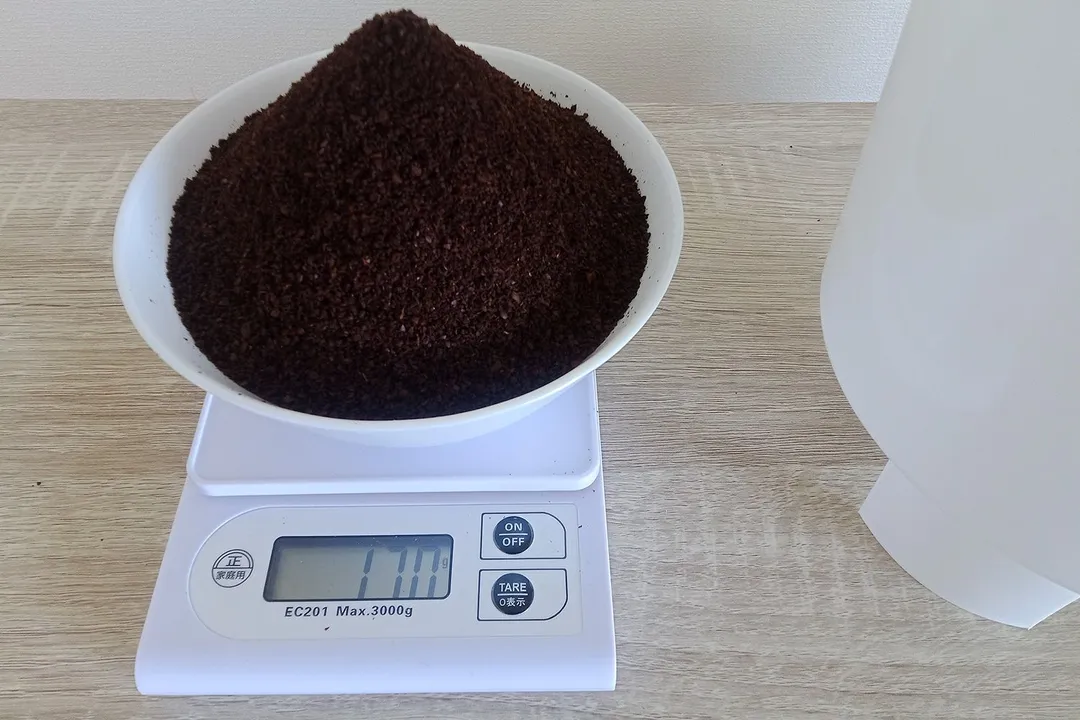
Immersion-filter brewers don’t demand much thought. You can measure the grounds if you wish, but for the most part you simply fill the filter to about an inch below the top.
For free-style brewers, you generally have to weigh out the grounds. The exception to this is the OXO Compact which has measuring lines for both grounds and water. Of course, with these brewers, you can change your brew ratio and brew volume as you desire.
Different Styles and Ways of Brewing
We found that different brewers recommend different styles of brewing. It’s hard to say how much difference these techniques make in the final coffee, especially among immersion brewers. Some brewers (like the Takeya) advise adding the water first and then immersing the filter filled with grounds. This is the fastest preparation method.
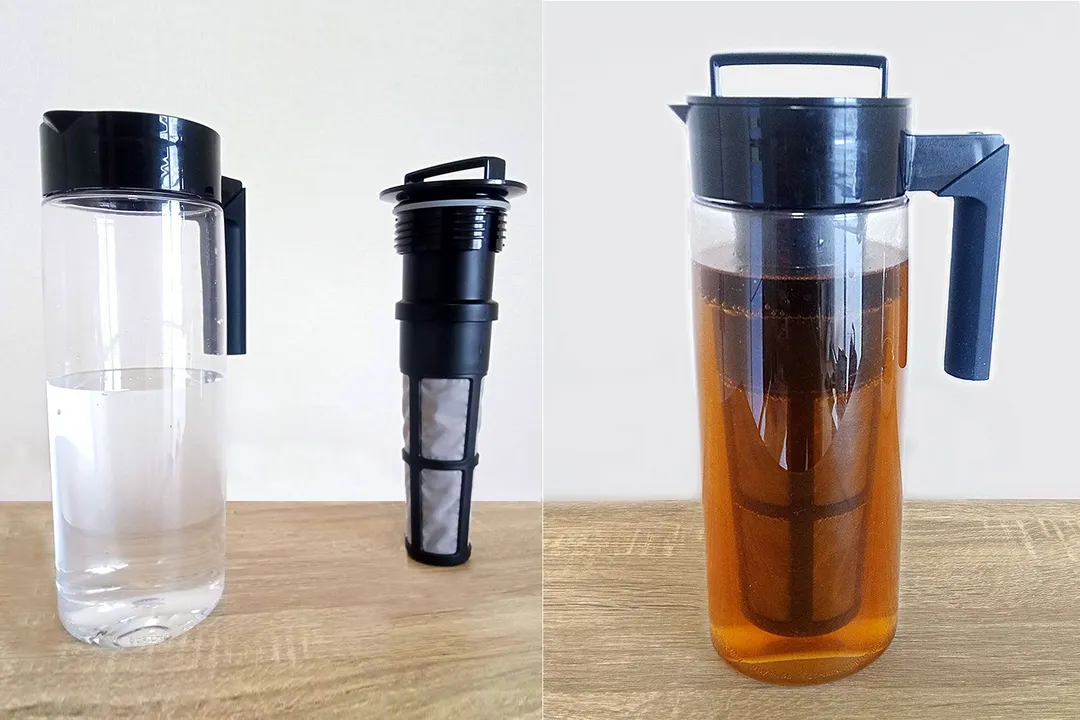
However, we feel it’s probably better to pour at least some of the water through the grounds and then allow the moistened grounds to bloom for a few minutes before adding the rest of the water.
For larger brewers, it's often better to partially fill the brew vessel with water before starting. When you’re pouring water over the grounds, you’ll have to slow down as you go to allow that water to filter through. Ultimately, you want to add enough water to cover the grounds.
For free-style brewers, we found that a gradual layered process produced the best results. For this method, you first place a third of the grounds in the bottom and then add an equal amount of water. You then repeat the process without stirring the grounds, but just gently pushing the grounds down to wet them properly.
Issues with Decanting and Filtering

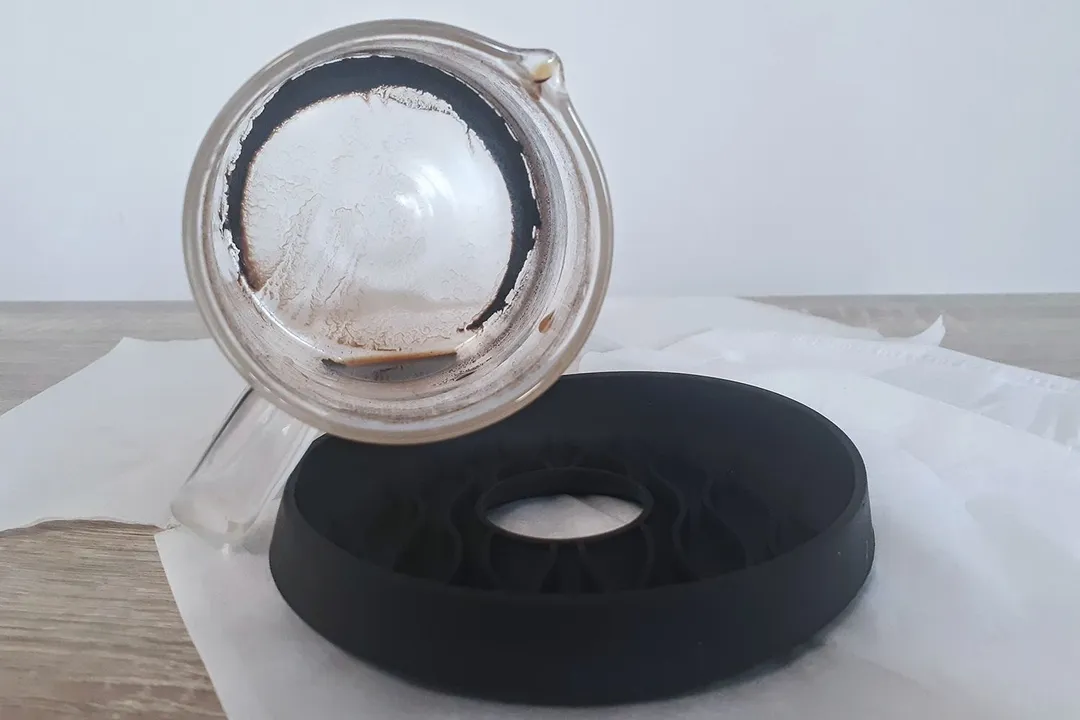
Most people expect immersion filtration to be the most convenient brewing method. We found this only holds true if you need to brew in the fridge door. Not only do free-style brewers produce better coffee, but their filtration methods are also superior.
For most immersion filters, we still recommend you allow the brew to settle and then decant the contents to remove the excess sludge left behind. Unfortunately, if you choose an immersion brewer with a very fine filter, the brew quality tends to be weak because the grounds don’t receive enough cross flow during the brewing period.
Check out full How We Test Cold Brew Coffee Makers for more information.
How Our Recommendations Are Made
Recommendations are based upon the resulting scores of our testing procedures. We take into account the specialized strengths of a product, the situation it’s best suited for, or the personal circumstances it is likely to best match.
Reviews of the Best Cold Brew Coffee Makers 2024
We purchased and tested nine cold brew coffee makers based on their reputation, popular appeal, size, and design. Two brewers failed to make the cut.
1. Best Overall: Toddy Cold Brew System

Things We Like
- Minimal parts
- No over-packaging
- Eco-friendliness
- Ergonomic components
- Attractive carafe
- Included paper filter bags
- Cold or hot brewing
Things We Don’t Like
- Felt filter tends to clog
- No brew vessel markings
The Toddy Cold Brew System was one of the very first home cold brew coffee makers on the market. Its performance and simplicity have stood the test of time, and it’s still the best cold brew coffee maker we’ve tested. The profile of its brew is rich, complex, and everything you would want for a top-rate cold brew coffee.
The device itself is relatively large. It produces around 40 fl.oz or 1.2 L of cold brew concentrate. This can be diluted to a ratio of 1:2 or even 1:3. The recommended brew ratio of 12 oz grounds to 56 fl.oz water works out to a ratio of 1 to 4.6. We found this to be a very favorable brew ratio, but you can adjust the measurements to brew smaller volumes or to a different ratio.
The main issue with the Toddy is that sometimes the felt filter is difficult to work with. It can clog and takes time to decant. The new product edition now includes brew bag filters to make things easier. The brew vessel is quite heavy so you need to carry it with two hands. Although the detachable handle may feel flimsy, its practical design actually works well for placing in a refrigerator.
We can’t fault the decanter in any way; it works well both aesthetically and in the excellent design of the stopper. The whole brew system also stores away very neatly. We also love its versatility — the brew bags work just as well with tea as coffee. The product also comes very ecologically packaged and is made in the USA. Note, though, that when you buy the Toddy, you commit to also buying replacement filter plugs or brew bags.
Read our full Toddy Cold Brew System in-depth review
2. Runner-up & Best French Press: Bodum Cold Brew Coffee Maker
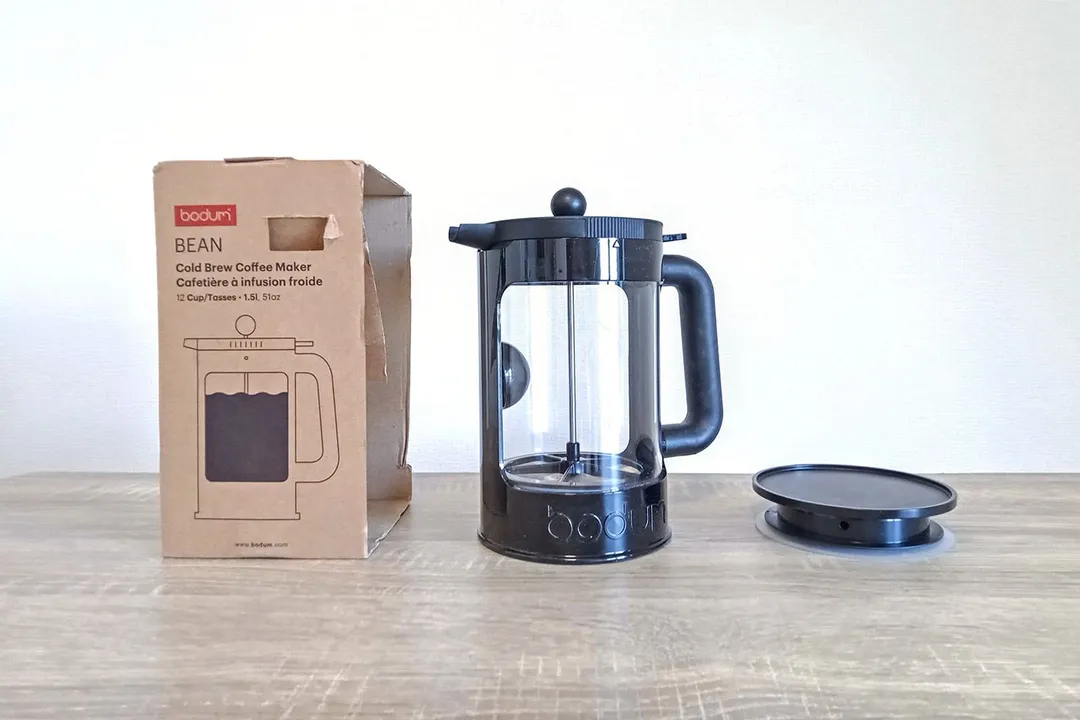
Things We Like
- Light and durable
- Open/close spout
- Perfectly airtight
- Comfortable handle
- Freestyle brewing
- Made in Portugal
Things We Don’t Like
- Decanting can be tricky
- No measuring guides
Bodum’s adaptation of the French Press design is an excellent product. It uses a free-style brewing method so you can adjust the brew ratio and quantity as you please. We used a 1:5 brew ratio in our testing and the concentrate was flavorful and of excellent strength.
One thing to consider about the Bodum is that plunging the filter down does require a bit of force. Nevertheless, we think it’s one of the best and easiest filtration methods. The brew carafe itself is plastic, so it is light and extremely durable. Decanting is simply a matter of pushing the plunger and pouring.
One quirk with the design is that if you want to remove the grounds after brewing, then you need to have your own vessel to decant into. You could return the brew to the original carafe, but a separate and more ergonomic carafe may be a better choice. The Bodum is made in Portugal and comes in a very practical eco-friendly package.
Read our full Bodum Cold Brew Coffee Maker in-depth review
3. Best Small: OXO Compact Cold Brew Coffee Maker

Things We Like
- Compact design
- Quality packaging
- Aesthetic decanter
- Easy measuring
- Pours very smoothly
Things We Don’t Like
- Stopper doesn’t fit tightly
- Sensitive decanter valve
- Brew not so complex
The OXO Compact cold brew coffee maker, as the name suggests, is OXO’s small answer to their popular OXO Good Grips cold brewer. It uses the same brewing method with the unique ‘rainmaker’ water dripper and an airtight lid.
The recommended brew ratio of the OXO Compact works out to 1:4. Although slightly less than the Toddy, we found that the OXO produces a stronger brew with a more defined rather than complex profile. We suspect this is so because of its water dripping system. We recommend adjusting the ratio or brewing for a shorter time if you prefer a milder flavor.
The design of the OXO is well thought out in terms of keeping things compact. Everything about this brewer is effortless - from brew vessel and decanter markings to cleaning and storage.
There are more parts to the OXO than most brewers, and the spring-loaded decanter valve is very sensitive so you should be careful when handling it. Also, we felt the decanter was rather delicate and the stopper didn’t fit securely. The reusable mesh filter does a good job, and you don’t have to commit to additional purchases.
Read our full OXO Compact Cold Brew Coffee Maker in-depth review
4. Best Immersion Filter Brewer: Ovalware Cold Brew Coffee Maker
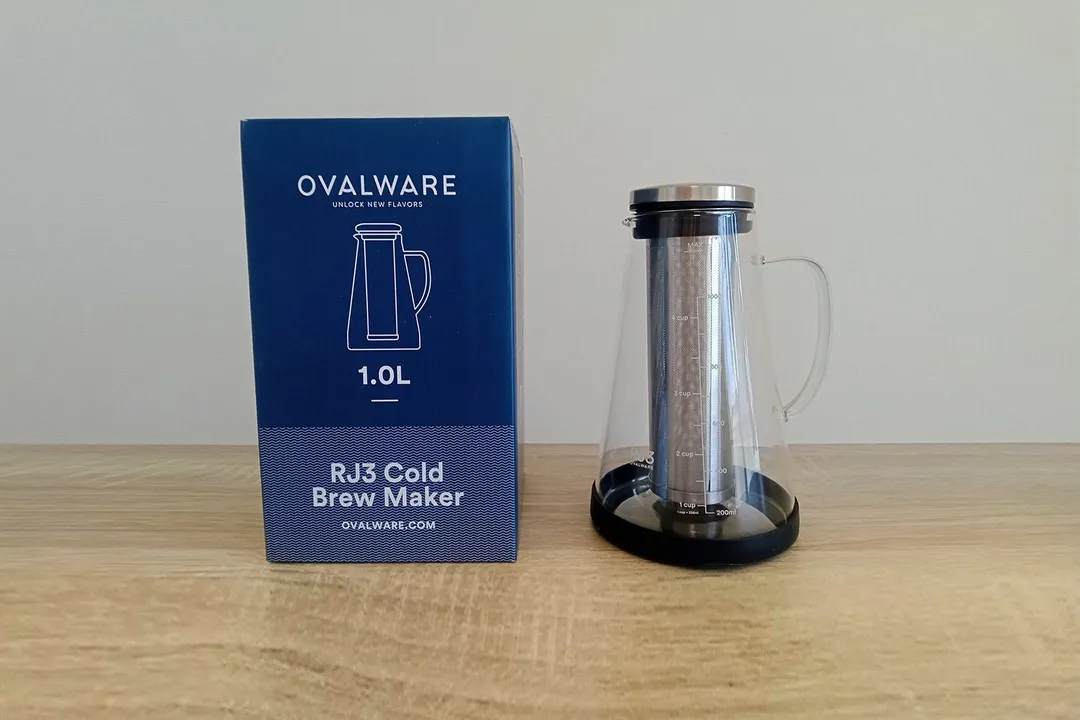
Things We Like
- Brew quality
- Brew markers in cups and ml
- Silicone base pad
- Comfortable handle
- Ease of brewing
Things We Don’t Like
- Quality and fit of silicone seals
- Additional decanting
- Narrow head for cleaning
When it comes to the array of immersion filter cold brew coffee makers, Ovalware ranks as one of the best in our tests. We really liked how the brewer was able to bring out sweeter profiles.
The brew ratio works out to 1:11 which is typical for similar brewers. The relatively porous and lengthy filter, coupled with the narrow neck and wider brewing area lower down seem to be key to this brewer's success. However, we found that the brew required additional decanting to remove excess sediment.
Design features we appreciated the most were the rubber base pad, the small lip that won’t chip easily and the excellent grip and pouring performance. Cleaning takes a little extra effort because you need to use a bottle brush if you wash by hand. The only room for improvement is the rather average quality of the silicone seals.
Read our full Ovalware Cold Brew Coffee Maker in-depth review
5. Best Value: Takeya Cold Brew
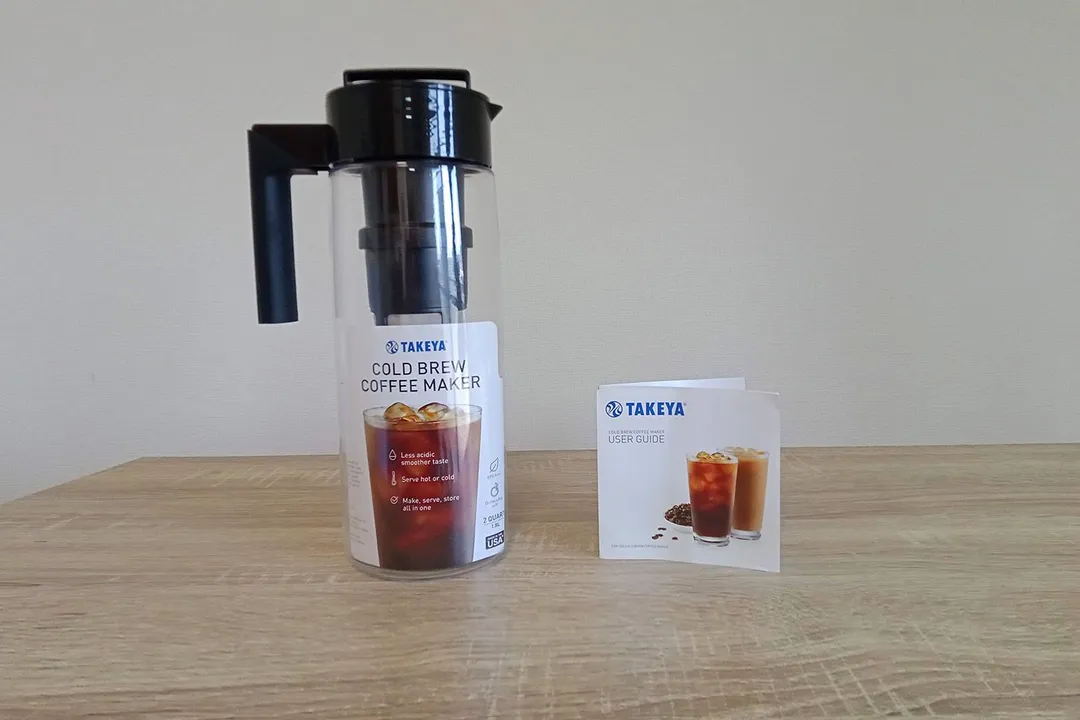
Things We Like
- Air tight brew decanter
- Cold or hot (tea) brewing
- BPA-free
- Dishwasher safe
- Durable & light weight
- 1 and 2 quart sizes
- Color choice
Things We Don’t Like
- Inadequate packaging
- Included instructions inadequate
- Filter cleaning
The Takeya is a relatively large cold brew coffee maker. Its full capacity is 2 quarts, though only 1.75 of that (56 fl.oz) is liquid volume when you’ve added the filter and grounds. After decanting, you’ll come out with 40 fl.oz (1.25 qt) or about 1.2 liters. This is the same as the Toddy.
The Takeya ranks as one of our top immersion brewers for brew quality, but when considering the brew ratio of 1:9, it didn’t perform as well as the Ovalware as far as cost efficiency goes. The advantages of the Takeya, however, are the durability of its Tritan plastic and the complete airtight and spill-proof design. You can lay the container on its side and no liquid will spill out. This also makes it very versatile and portable.
One point we took issue with was the design of the filter. Sometimes it doesn’t attach so securely to the lid, and if you shake the vessel too vigorously, you’ll have a lot more sediment to deal with after decanting. The filter is also quite long, and the complete unit separates into seven parts for cleaning, which is more than average.
Read our full Takeya Cold Brew in-depth review
6. Most Practical Design: County Line Cold Brew Coffee Maker

Things We Like
- Versatile product
- Minimal packaging
- Packed and shipped in the US
- Robust and durable
- Airtight silicone gasket
Things We Don’t Like
- Brew strength average
- Filter not so effective
County Line Kitchen’s mason jar cold brew coffee makers eschew fancy design for simple home-style practicality. The brewers come in 1- and 2-quart sizes and you can choose a screw-on lid with or without a handle. We brewed with the 1-qt size in a small refrigerator and it was a perfect fit.
The County Line’s brew quality also ranks as one of our top five favorites. We recommend decanting the brew a second time because of excess sediment. The filter appears coarse, but it produces a better brew than the finely machined stainless steel ones. There’s not much to dislike about this brewer.
Read our full County Line Cold Brew Coffee Maker in-depth review
7. Best 1-Gallon: Willow & Everett Cold Brew Coffee Maker

Things We Like
- Funky design
- Brew ratio
- Brew quality
- Tap dispenser
Things We Don’t Like
- Lid design
- Weak glass around tap
- Tap is temperamental
- No literature
The Willow and Everett is a mason-jar-inspired design with a spigot for easy dispensing. What we liked most about this cold brew cold coffee maker was the favorable brew ratio (1:9) and the double filtration system.
We tested the smaller half-gallon brewer and while the quality of the brew was pretty good, the overall build quality was somewhat of a compromise.
The spigot tended not to work so well for one-hand operation, and the glass on the half-gallon size is thin and fragile around the spigot. The 1-gallon version, however, is slightly more robust and we feel it is the better design. A good portion of the brew doesn’t dispense through the spigot, so you have to drain it out via the top.
Read our full Willow & Everett Cold Brew Coffee Maker in-depth review
8. Best Shout-out to a Cold Brew Coffee Maker: Bean Envy

Things We Like
- Two lid design
- Silicone base
- Handle design
- Measuring markers
Things We Don’t Like
- Filter bottom
- Pouring with silicone lid
Bean Envy is another all-round excellent choice for a cold brew coffee maker. It’s very similar in design to the Ovalware and the brew quality is just as good, if not slightly better and brewed to a ratio of 1:12. We really like the fit of the silicone base stand, which was far better than other similar designs.
The double lid design of the Bean Envy, while innovative and thoughtful, doesn’t pour so well in practice. This type of design also means that you have an extra lid to keep track of when not in use. The customer service is also top-notch.
Read our full Bean Envy in-depth review
Nearest Competitors
- Aquach Cold Brew Coffee Maker - A glass and stainless steel 34oz (1L) brewer. Great aesthetics and a high-quality design. The filter is a bit too fine for making good cold brew, but works well for hot brewed drinks.
- Coffee Gator Cold Brew Coffee Maker - A slender glass carafe brewer ideal for in-door brewing in your refrigerator. The included stainless steel measuring spoon and silicone funnel are helpful, and it’s all topped with an extended warranty.
- Goodful Cold Brew Coffee Maker - A tall plastic brewer that can hold up to 68oz (2L) of liquid. The filter is of good quality, but the lid is clunky. However, we appreciate that it can be stored on its side once decanted. It’s similar to the Takeya which is a better quality proposition.
- Coffee Bear Cold Brew Coffee Maker - An almost identical design to Coffee Gator. The additional silicone base is not well-designed and you may have to remove it to store the decanter in a small fridge door. Nothing about the design makes it better value than the Coffee Gator which, on the other hand, comes with value added extras.
Cold Brew Coffee Makers to Avoid and Why
In our test laboratory, we discovered two fundamental design flaws that generally precluded us from recommending a particular brewer. One reason is a non-airtight container and the other a poorly designed filter.
- Primula Burke Deluxe - We liked the Primula Burke Deluxe’s overall design. We were disappointed that despite its handy 1.6 qt size, short stature, and popular appeal, the brew quality fell flat. The issue was the filter design. It was too fine and the plastic skeleton decreased cross-flow even further. As a result, the flavor just didn’t diffuse.
- Hario Mizudashi - The Hario Mizudashi is also an attractive brewer. Its long and slender design was perfect for brewing in the door of a small refrigerator. The vessel, however, is not airtight, the filter is too short, and the brew ratio failed to create an acceptable cold brew.
- Cafe Du Chateau - Although the quality of the brew is average, the attractive French press design is flawed. The device is heavy and poorly weighted while the stopper and lid design is cumbersome. If you want to brew with a French press, nothing beats the Bodum cold brew coffee maker.
Choosing the Best Cold Brew Coffee Maker
Selecting the best cold brew coffee maker depends on your needs and priorities. If you’re after a top quality concentrate, the choice won’t be so difficult. If you’re looking for a convenient immersion filter brew carafe with a good enough brew, you need to choose more carefully.
Bottom Filter vs French Press vs Immersion Filter


Free-style brewers allow grounds to float “free” in the brewing vessel along with the water. The final brew is then decanted and filtered into a separate carafe, usually by opening a plug in the base or pushing down a French-press-style plunger filter.
The advantage of this method is that you can decide on your own brew ratio and choose exactly how much or how little you want to brew. Some free-style brewers can also accept a paper coffee bag or coffee sock.
The other style immerses a filter filled with grounds into a brew carafe. Some users prefer them for their convenience, size, filtration, and fast decanting.
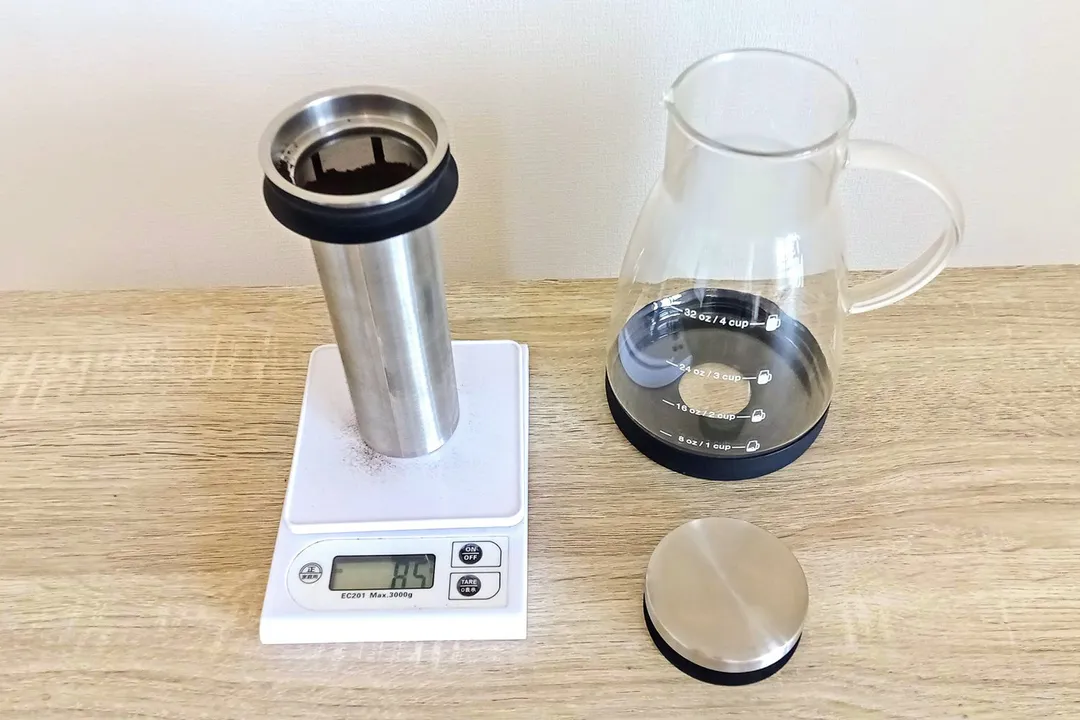
Of the two, however, our repeated hands-on cold brew coffee testing showed that free-style brewing produces a higher-quality brew. This is partly due to better and more customizable brew ratios.
The other reason seems to be that the grounds in a free-style brewer are more exposed and become less compressed together during brewing compared to an immersion filter. The design and permeability of an immersion filter also impacts brew quality and the brew ratio is more-or-less fixed.
For free style designs, our top choices are the Toddy Cold Brew System, the OXO, and the Bodum French press. If you prefer an immersion design, there’s quite a wide range to choose from.
The Best Immersion Filter Design


For immersion type brewers, a filter that’s too fine tends not to allow enough permeability to infuse a good quality brew. A more porous filter generally means a better tasting brew, but you may have to decant the brew a second time to remove the sediment that settles on the bottom.
At the same time, you may prefer to filter the entire contents through a paper filter. This produces a lighter-bodied brew which may also be healthier because paper filtration removes coffee oils. However, there aren't many studies on the health properties or otherwise of cold brewed coffee.
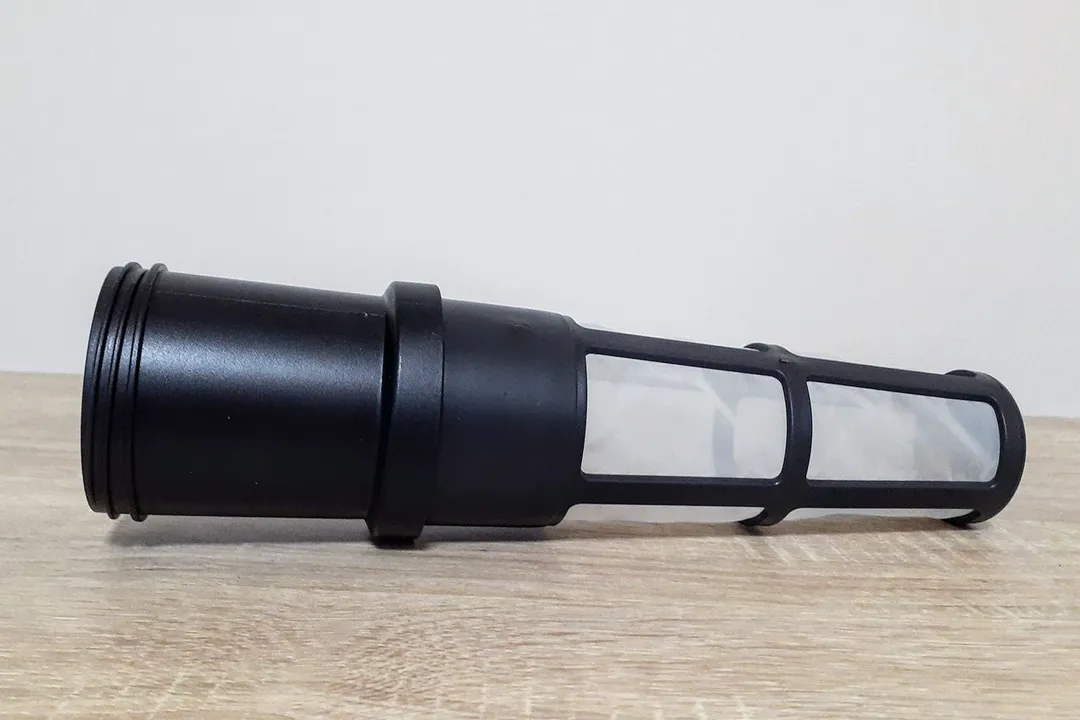
Secondly, immersion filters have a more-or-less fixed brew ratio. This can vary between brewers anywhere from a ratio of 1:8 to 1:14 of grounds to water. There are ways to boost the brew strength or flavor. You can brew for a longer time, brew at room temperature, start by hot blooming, or brew with flavor enhancers such as chicory.
In our brew testing, we also discovered that longer immersion filters tend to do better, especially if the carafe has a wide base. Filters are either made of stainless steel, a mesh gauze, or a type of polyester nylon. Stainless steel or mesh gauze filters are generally the better choice, and they are more versatile for hot brewing. Super-fine laser-cut stainless steel filters, however, tend not to allow enough cross-flow.
The Need for Airtight Brewing
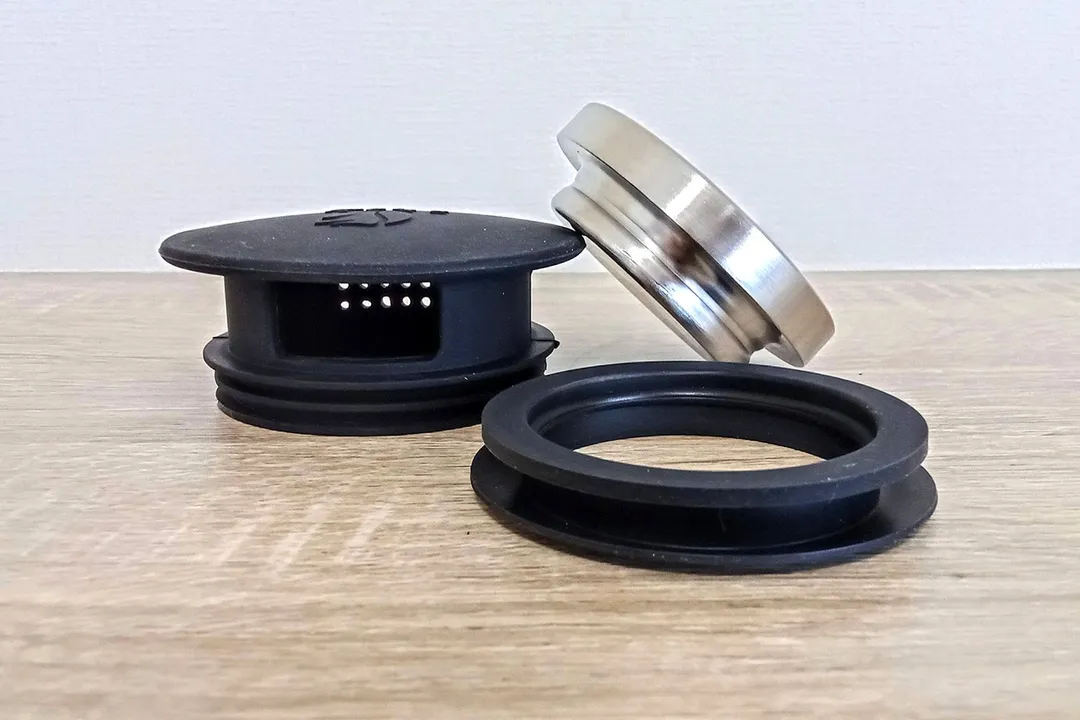
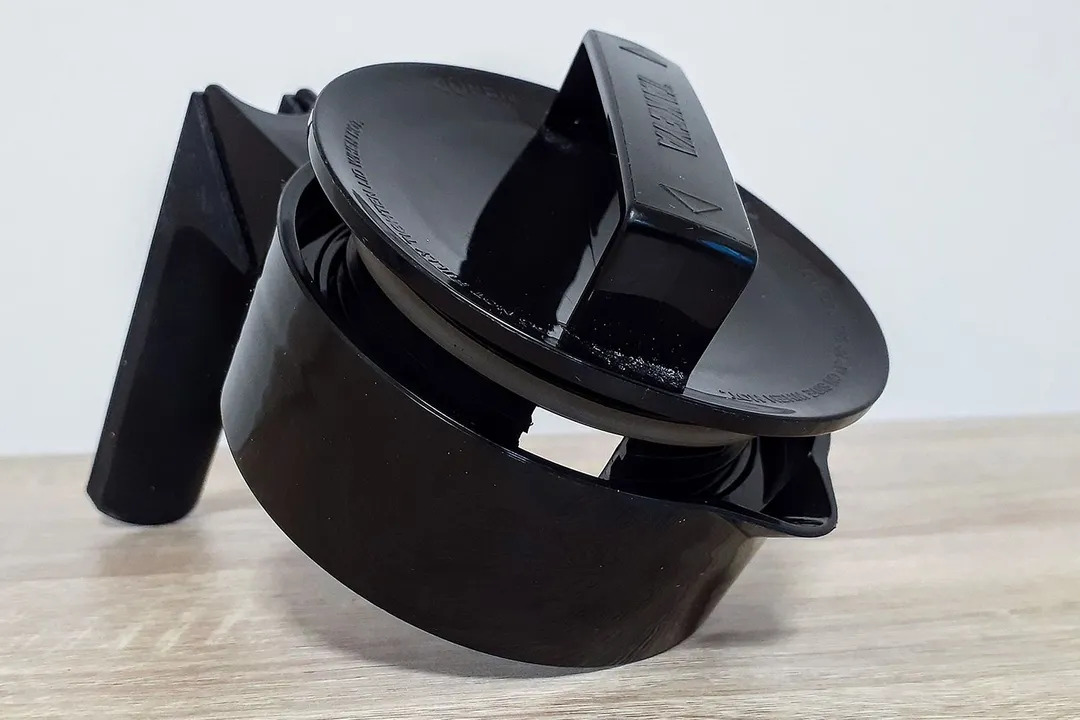
Cold brewing happens over the course of 18 to 24 hours, usually in the refrigerator. To prevent odor contamination and oxidation during that time, the brew decanter needs to be airtight both during and after brewing. Most decanters are airtight while brewing, but may not be so tight fitting once the filter is removed.
Designs with screwable lids like the Takeya, Goodful, County Line, Willow & Everett, and Coffee Gator do not have an airtight issue after decanting. Designs that have a stopper may vary in quality for airtightness while storing the brew. Bean Envy has a unique design using two lids and the Bodum French press is similar.
Getting a Handle on Things
Many cold coffee brewers can hold at least 40 oz (1.2 L) and some are much larger. It’s important that you can maintain a secure grip while lifting, so a strong handle and comfortable grip can be important. The other factor is how well the decanter is balanced for pouring.
Depending on the design and height of the decanter and filter, you may need a bottle brush for cleaning. Filters may also require periodic descaling. Most brewers can go into a dishwasher, but it’s best to just rinse off the silicone seals or gaskets. If you don’t want a device with too many parts, our detailed single product reviews each give a parts count.
Brewing to Size and Circumstance
Another factor when making your own cold brew coffee is your available space, especially in the refrigerator. Check the brewer vessel or brew decanter dimensions if you want to stand it on a refrigerator shelf or in the door.
If you have a small refrigerator or minifridge, brewers like Toddy, OXO Compact, or Bodum may fit in the crisper box, but in some cases only if you remove the bottom shelf. You can brew outside of the refrigerator, but you’ll still need to refrigerate the coffee concentrate once it’s ready. Cold brew coffee concentrate can keep in a refrigerator for 10 to 14 days.
Brew Ratios and the Economics of Cold Brewing
Opinions about the best grounds-to-water ratio vary widely. Most cold brew experts will recommend a 1:4 to 1:5 ratio. After brewing, you can decide how much to dilute the concentrate. Poor design, however, will result in low extraction regardless of the ratio, and translate into poor cost performance.
In our tabulation of 5 top cold brew coffee makers we tested, you can compare brew quality and brew ratios to the output volume or yield.
Brewer Model | Brew Quality Score | Grounds : Water Ratio | Yield & Dilution |
|---|---|---|---|
Toddy | 10 | 1 : 4.6 12 oz / 56 fl.oz | 40 fl.oz 1:2⁓1:3 |
OXO Compact | 9 | 1 : 4 6 oz / 24 fl.oz | 16 fl.oz 1:2⁓1:3 |
Bodum | 9 | 1:5 8 oz / 40 fl oz | 25 fl oz 1:2⁓1:3 |
Ovalware | 7.8 | 1 : 11 3 oz / 34 fl oz | 30 fl.oz 1:1 |
Takeya 2 Quart | 7.8 | 1 : 9 6 oz / 56 fl.oz | 40 fl.oz1:1 |
Ultimately, how far the brew goes depends on how much you prefer to dilute the concentrate. If the concentrate brewed by the Toddy, OXO Compact, and Bodum are diluted 1:1, and the immersion filters’ brew is drunk straight, here is the approximate economics of how much coffee you get per 1 oz of grounds:
- Ovalware - 10 fl.oz
- Toddy - 6.6 fl.oz
- Takeya - 6.6 fl.oz
- Bodum - 6.2 fl.oz
- OXO - 5.3 fl.oz
The Toddy, OXO, and Bodum could even be diluted to a ratio of 1:2 or up to 1:3, or the brew ratio can be adjusted to increase the output volume. If you’re aiming for balance between quality and quantity, the Toddy is still the top contender. For immersion filter brewers, the Ovalware is the best economic choice, especially considering increasing coffee prices.
Cold Brew Coffee Q&A
Cold brew, or cold-brewed coffee, takes longer to make. Initially, the grounds are soaked in room-temperature water and then brewed cold in a refrigerator anywhere from 12 to 24 hours. Iced coffee, on the other hand, is usually hot-brewed like most coffees before being served chilled. Japanese iced coffee makers flash-brew hot coffee directly over ice. Dutch iced coffee calls for melting ice to be slowly dripped over coffee grounds. Each brew method extracts a different flavor profile.
Cold brew coffee comes out stronger than drip coffee and with a unique flavor profile. It generally has a milder, smoother, and often sweeter flavor. A good cold brew concentrate can also produce an espresso-strength drink. It is an excellent mixer or dessert ingredient. And because the grounds are not exposed to high heat, a cold brew can last up to two weeks in a refrigerator.
Cold brew concentrate is the concentrated coffee that you get directly from the brewing device. However, not all cold brew coffee makers produce concentrate; it depends on a number of factors. If the brew ratio is greater than 1:9 the resulting brew is not really strong enough to qualify as a concentrate. Also, if you use an immersion basket filter which is not permeable enough, it won’t get sufficient crossflow for a quality brew (concentrated or otherwise).
If flavor is your top goal, the best cold brew coffee ratio is somewhere around 1:4 or 1:5. Generally, the only cold brew coffee-making devices that accomplish this are those that use a free-style brewing method. An immersion filter cold brew coffee maker will usually have a fixed ratio. Depending on the device, this can range from 1:9 up to 1:14.
Generally, yes. A good cold brew concentrate, made to a grounds-to-water ratio of 1:4, can itself be diluted at a ratio of 1:3 to reach regular coffee strength. Cold brew concentrate is the ‘espresso of cold coffee’.
Cold brew coffee can, of course, be drunk straight. If it’s a concentrate, then you can add water until it reaches your preferred strength. As with any coffee, you can add milk and/or sugar or any sweetener to taste. The key difference is that with a cold brew concentrate you can mix to a larger volume of milk or other liquid. This is great for a concentrated flavor, a caffeine boost, or a protein shake or smoothie.
Why Trust Us
At HealthyKitchen101, we let the products speak for themselves via rigorous testing. No sponsored content, no unsubstantiated claims, only evidence-backed reviews.
- Unbiased: We purchase all the products of our own accord and for testing purposes only. We do not procure sponsorship or donations and have no stake in the reputation of the brands.
- Verifiable: Our testing procedures are data-driven. Each test is rigorous and transparent; we detail the process, provide the data, and present evidence.
- Objective: Our tests are collaboratively developed. We establish most testing procedures in house and consult with outside experts when necessary. To ensure accuracy, culinary aspects of our procedure, such as cooking and taste-testing processes, are consulted with professional cooks.
Our Expertise
Your cold brew coffee guide, Roger Shitaki, has spent over a decade traveling and working between two great coffee nations, Japan and Vietnam.
Japan is often considered the origin of the first commercialized cold brew coffee technique, namely Kyoto ice-dripped coffee. Kyoto’s most elegant drip coffee towers, however, are not exactly the same as the long steeping method used here.
Current day cold brewed coffee has only become popular over the last decade. Although quite a simple procedure, we uncovered many quirks and surprises from brewing multiple times with up to 15 different brew jugs and contraptions.
In this way, we discovered what works and doesn’t work when it comes to a great cold brew coffee maker.
Although parameters can vary widely with any coffee brewing, we were careful to brew with the same bean blend for all our tests. Fortunately, cold brew happens in the refrigerator which offers the perfect controlled environment. In the future we look forward to brewing again with deeper insights and a more developed methodology.
About your guide
Roger Shitaki is a writer, author, and editor. His niches are household appliances, health & wellness, and travel. He’s a freelance contributor to a Tokyo lifestyle website and a leading ophthalmology magazine in Asia.
Luna Regina is an accomplished writer and author who dedicates her career to empowering home cooks and making cooking effortless for everyone. She is the founder of HealthyKitchen101.com and HealthyRecipes101.com, where she works with her team to develop easy, nutritious recipes and help aspiring cooks choose the right kitchen appliances.

